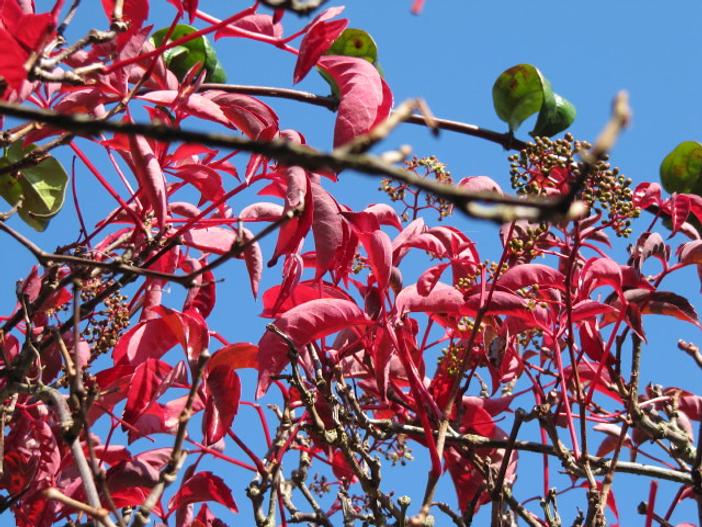Chinese Virginia-Creeper
(Parthenocissus henryana)
Chinese Virginia-Creeper (Parthenocissus henryana)
/
/

Leonora (Ellie) Enking
CC BY-SA 2.0
Image By:
Leonora (Ellie) Enking
Recorded By:
Copyright:
CC BY-SA 2.0
Copyright Notice:
Photo by: Leonora (Ellie) Enking | License Type: CC BY-SA 2.0 | License URL: https://creativecommons.org/licenses/by-sa/2.0/ | Uploader: wallygrom | Publisher: Flickr

















Estimated Native Range
Summary
Parthenocissus henryana, commonly known as Chinese Virginia-Creeper, is a deciduous perennial vine native to forest margins, rocky areas, and mountain slopes in China. It is a less vigorous climber compared to other species in the genus, reaching up to 10 meters (33 feet) in length. Its palmate leaves, which consist of five leaflets, are distinctive with silver veins and a blue-green hue, turning to a brilliant red in autumn before falling. During the summer, it produces clusters of small, inconspicuous greenish flowers, which may be followed by attractive blue-black berries if pollinators are present.
This vine is valued for its ornamental foliage, particularly its striking autumn coloration. It is suitable for growing on walls, trellises, and as a ground cover on slopes, making it versatile for various garden settings. It can also be grown in large pots. Parthenocissus henryana has earned the Royal Horticultural Society’s Award of Garden Merit, indicating its excellence for garden use. For best growth, it requires full sun to part shade, low to medium water, and well-drained soil. While it can be propagated from seeds or cuttings, it is important to note that the berries can be toxic if ingested. Gardeners should also be aware that the tendrils can damage mortar and wood over time, so careful placement is advised to prevent structural damage.CC BY-SA 4.0
This vine is valued for its ornamental foliage, particularly its striking autumn coloration. It is suitable for growing on walls, trellises, and as a ground cover on slopes, making it versatile for various garden settings. It can also be grown in large pots. Parthenocissus henryana has earned the Royal Horticultural Society’s Award of Garden Merit, indicating its excellence for garden use. For best growth, it requires full sun to part shade, low to medium water, and well-drained soil. While it can be propagated from seeds or cuttings, it is important to note that the berries can be toxic if ingested. Gardeners should also be aware that the tendrils can damage mortar and wood over time, so careful placement is advised to prevent structural damage.CC BY-SA 4.0
Plant Description
- Plant Type: Vine
- Height: 10-20 feet
- Width: 3-4 feet
- Growth Rate: Rapid
- Flower Color: N/A
- Flowering Season: Spring, Summer
- Leaf Retention: Deciduous
Growth Requirements
- Sun: Full Sun, Part Shade
- Water: Low, Medium
- Drainage: Medium
Common Uses
Bee Garden, Bird Garden, Butterfly Garden, Deer Resistant, Drought Tolerant, Groundcover, Low Maintenance
Natural Habitat
Forest margins, rocky areas, and mountain slopes in China
Other Names
Common Names: Silver Vein Creeper, Chinesische Jungfernrebe, Kinavildvin
Scientific Names: , Parthenocissus henryana, Vitis henryana, Ampelopsis henryana, Parthenocissus henryana var. henryana, Parthenocissus multiflora, Psedera henryana,
GBIF Accepted Name: Parthenocissus henryana (Hemsl.) Diels & Gilg